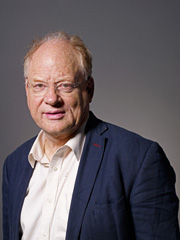Peter Kassig beheading: video hints at turning point for IS
More rudimentary filming suggests Islamic State is on the run: if anything, the movement is spreading

The murder of Peter Kassig has been portrayed by Islamic State terrorists in the same manner as the killings of his fellow British and American prisoners earlier this summer – but there are differences. Those differences suggest that IS is reaching a critical turning point in how it operates regionally and globally.
The whole video production seems less professional and more hurried than before, according to US and French analysts who have examined the new footage.
Kassig himself, a former US Army Ranger, may have put up a fight: the blood splashes on the boots of the British executioner ‘Jihadi John’ suggest that.
The Week
Escape your echo chamber. Get the facts behind the news, plus analysis from multiple perspectives.

Sign up for The Week's Free Newsletters
From our morning news briefing to a weekly Good News Newsletter, get the best of The Week delivered directly to your inbox.
From our morning news briefing to a weekly Good News Newsletter, get the best of The Week delivered directly to your inbox.
The concluding scene, showing what purports to be Peter Kassig’s head, is jerkily filmed on one camera. Previous IS beheadings were shot with several cameras from several angles, giving a “professional look” to their propaganda.
The 16 minutes leading up to Kassig’s execution provide a rambling history of IS - how it has inherited the mantle of Osama bin Laden and is now taking over the al-Qaeda brand. Towards the end of the narrative, we see a file of prisoners led out, some held by their hair, and made to kneel down. The band of IS brothers take knives and cut the throats of their charge.
The victims have been identified as soldiers and airmen of the hated Alawite-Shia regime of Bashar al-Assad. The IS mob make no attempt to conceal their faces, though features are obscured as the camera looks into direct sunlight.
The killings take place in a different terrain from the bare hillside outside Raqqa where John Foley, Steven Sotloff, David Haines and Alan Henning were murdered.
A free daily email with the biggest news stories of the day – and the best features from TheWeek.com
This suggests that the IS executioners are no longer safe in Raqqa nor in the suburbs of Aleppo, where it is known the hostages were held for some time. So, IS is no longer as invincible as it proclaims - or is it?
The myth of invincibility has been dented by the battle for Kobane on the northern Syrian border with Turkey, where the battle-hardened Kurdish Syrian militia have toughed it out for months. Kobane was supposed to provide an emblematic victory over the Kurds, though it holds little strategic importance for IS as such.
Kobane is the capital of one of the three provinces the Syrian Kurds have carved out as their own self-governing entity, similar to but separate from the Kurdish Regional Government area in Iraq.
The new Kurdish map has been described brilliantly in an outstanding essay by Patrick Cockburn in the London Review of Books. He explains that IS is now being contained to a swathe of territory running from northwest Syria, along the river systems of the Euphrates and Tigris to the approaches of Baghdad. A combination of allied air strikes and Shia militias on the ground – for the Iraqi army hardly exists now – has pushed them off strategic targets such as the Mosul and Haditha dams and the Baglia oilfields.
But there is little prospect of an outright defeat for IS on the ground. Its forces may be “really hurting” as the BBC’s Frank Gardner infers from his intelligence sources, but there is no indication that IS can be dealt with by a credible ground force of Iraqi and allied Arab troops. As things stand, this just isn’t going to happen.
The real shock for the US and its Western allies this summer was not the appearance of IS itself (or Isis/Isil) but the collapse of the Iraqi national army – in particular the flight of four divisions in Mosul in early June.
The Americans are now trying to rebuild the Iraqi army, albeit on a more modest and more practical scale. But the restrictions imposed by the Obama administration make this look pretty forlorn. The training is at brigade level and above; and Americans are forbidden from working in and among units in a fight – which is key to top-quality training.
The Islamic State’s toughest opponents on the ground so far have been the Iraqi Shia units and militias and the Syrian Kurds. Hence the significance of the ragged, rambling video heralding the death of Peter Kassig.
It shows that while IS still has a problem with some highly independent Sunni tribes in Iraq, who reject its sadistic, self-defeating gospel, it now sees the Shia forces as its main opponent in Iraq, the region and the world.
The new video threatens further attacks on the streets of the cities of the Western World. This is to encourage the low-tech efforts of ‘lone wolf’ pyschopaths, though they do not appear to be a main effort in the IS terror campaign – at least for the time being.
The main effort is now spreading the IS franchise across the region. In Egypt IS is now linked with the Ansar Beit al-Maqdis, who have been leading the insurrection against President Sisi’s regime in Sinai and from the western desert, ie Libya.
In Yemen, IS appears to have forged an alliance with al-Qaeda and Absar al-Sharia against the Shia al-Houthi insurgents, who took over Yemen’s capital Sana’a last September – virtually unnoticed by the world’s press.
The Yemen war raises the serious prospect that IS is on the way to full merger with al-Qaeda and even the Muslim Brotherhood in vulnerable regions. There have been hints in the regional press that IS is moving in with Pakistan Taliban and Kashmiri Islamist groups in India.
All this should be encouraging the international powers and agencies like the UN to come up with a coherent strategy. But as we have seen from last week’s G20 meeting in Brisbane, they can’t or won’t.
More pressing is the question of refugees in the Middle East and Mediterranean – where crisis seems on the cusp of turning into catastrophe. This why a corps of BBC correspondents - Mishal Husain, Lyse Doucet and Jeremy Bowen - have been devoting so much attention to the refugees in Kurdistan and Lebanon in recent days.
The refugees now make up a third of the population in Lebanon, where governance is at breaking point. Half of Syria’s population have fled their homes in the past three years. Many from the educated middle class and will seek to leave Lebanon and Jordan for Europe, travelling across or around the shores of the Mediterranean.
“They’ll never go back,” a senior UK diplomat in the region told me last week.
is a writer on Western defence issues and Italian current affairs. He has worked for the Corriere della Sera in Milan, covered the Falklands invasion for BBC Radio, and worked as defence correspondent for The Daily Telegraph. His books include The Inner Sea: the Mediterranean and its People.
-
 5 sleeper hit cartoons about Sleepy Don
5 sleeper hit cartoons about Sleepy DonCartoon Artists take on cabinet meetings, a sleepy agenda, and more
-
 Political cartoons for December 6
Political cartoons for December 6Cartoons Saturday’s political cartoons include a pardon for Hernandez, word of the year, and more
-
 Pakistan: Trump’s ‘favourite field marshal’ takes charge
Pakistan: Trump’s ‘favourite field marshal’ takes chargeIn the Spotlight Asim Munir’s control over all three branches of Pakistan’s military gives him ‘sweeping powers’ – and almost unlimited freedom to use them
-
 Femicide: Italy’s newest crime
Femicide: Italy’s newest crimeThe Explainer Landmark law to criminalise murder of a woman as an ‘act of hatred’ or ‘subjugation’ but critics say Italy is still deeply patriarchal
-
 Brazil’s Bolsonaro behind bars after appeals run out
Brazil’s Bolsonaro behind bars after appeals run outSpeed Read He will serve 27 years in prison
-
 Americans traveling abroad face renewed criticism in the Trump era
Americans traveling abroad face renewed criticism in the Trump eraThe Explainer Some of Trump’s behavior has Americans being questioned
-
 Nigeria confused by Trump invasion threat
Nigeria confused by Trump invasion threatSpeed Read Trump has claimed the country is persecuting Christians
-
 Sanae Takaichi: Japan’s Iron Lady set to be the country’s first woman prime minister
Sanae Takaichi: Japan’s Iron Lady set to be the country’s first woman prime ministerIn the Spotlight Takaichi is a member of Japan’s conservative, nationalist Liberal Democratic Party
-
 Russia is ‘helping China’ prepare for an invasion of Taiwan
Russia is ‘helping China’ prepare for an invasion of TaiwanIn the Spotlight Russia is reportedly allowing China access to military training
-
 Interpol arrests hundreds in Africa-wide sextortion crackdown
Interpol arrests hundreds in Africa-wide sextortion crackdownIN THE SPOTLIGHT A series of stings disrupts major cybercrime operations as law enforcement estimates millions in losses from schemes designed to prey on lonely users
-
 China is silently expanding its influence in American cities
China is silently expanding its influence in American citiesUnder the Radar New York City and San Francisco, among others, have reportedly been targeted